If one Swallow does not make a summer, what do two Swallows make? A lovely early spring tour in North Norfolk today, Easter Sunday. The weather forecast said it would be grey, overcast and cool all day today – but the skies cleared in the afternoon and it was beautifully sunny, even slightly warm, a great day to be out.
We started at Titchwell. There were already quite a few cars in the car park when we arrived, but the overflow area was still fairly quiet, so we had a quick look round. We could immediately hear a couple of Chiffchaffs singing and then a Bullfinch started calling. As we walked round, we could see it feeding on buds in the top of the sallows, a smart male Bullfinch. It flew further round and we found it again, in a Blackthorn amongst the flowers and emerging bright green leaves. A female Bullfinch was also nearby, and the two called to each other softly as they fed.
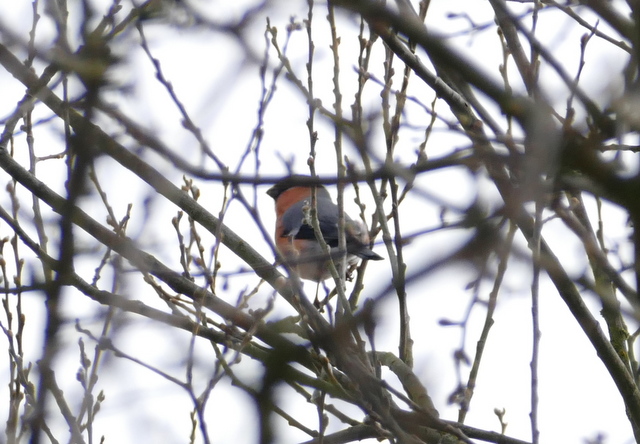 Bullfinch – a pair was feeding in the trees around the car park at Titchwell
Bullfinch – a pair was feeding in the trees around the car park at Titchwell
A couple of Cetti’s Warblers were also singing from the bushes around the car park, but we didn’t see them (they rarely show themselves – though read on…). A little group of Long-tailed Tits came through, calling. A Great Spotted Woodpecker flew west overhead.
We walked out onto the reserve. The Thornham grazing marsh pool is still fairly dry, though with a few puddles after the recent rain. There was not much to see on there today. We were scanning over the mud when one member of the group spotted a shape walk out from the reeds. A Water Rail came right out into the open and poked about in the mud. We got a really good look at it through the scope before it suddenly turned and ran back into the reeds.
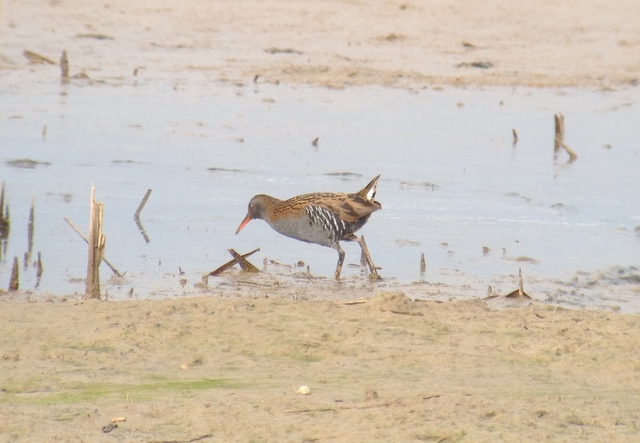 Water Rail – on the Thornham grazing marsh pool
Water Rail – on the Thornham grazing marsh pool
It didn’t take us long to find the Red-crested Pochards – a pair were lurking in the first of the dykes across the reedbed. Another three were on the main reedbed pool, with a smart pair right down at the front. A single Great Crested Grebe was at the back of that pool, completing the gaudy selection.
On a smaller and browner note, a Cetti’s Warbler was singing from some brambles in the reedbed. No surprise there, but a quick look in the direction of the noise revealed that it was actually sitting up in a small bare tree growing up through it. It stayed there for ages, dropping down for a second, before climbing back up again (it was still sitting in the same tree when we walked back an hour or so later!). For once, we got a really good look at it in the scope. We could also hear several Bearded Tits calling from the reeds, but they were less obliging – the best we could do was a quick flash as one shot across the reedbed pool.
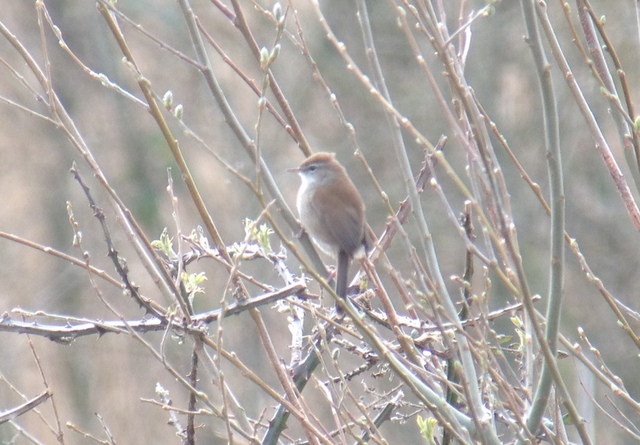 Cetti’s Warbler – perching up in full view, just for a change
Cetti’s Warbler – perching up in full view, just for a change
There were birds on the move as we walked out along the main path. A little flock of Starlings flew high over the reserve, heading east. A small group of Carrion Crows also looked like they were on their way somewhere – although we think of them as resident, some do migrate along the coast in the early spring. There was also a steady trickle of Meadow Pipits flying west overhead. Migration is underway and the early birds are on their way.
Marsh Harriers were much in evidence, but were not displaying today. We could hear one calling over the Thornham grazing marsh pool and later saw it circling over the saltmarsh, where it landed in a small Suaeda bush. The pair of Marsh Harriers in the main reedbed were busy nest building, flying back and forth from the reeds along the edge of the freshmarsh, carrying vegetation.
The freshmarsh is looking great now – the water levels have dropped and there are several islands back in view. There were lots of Avocets standing around on them today. A nice mixed group of godwits were roosting on the freshmarsh – giving us a great opportunity to look at the differences between the winter-plumaged Black-tailed Godwits and Bar-tailed Godwits. Several of the Black-tailed Godwits are now looking very orange, as they are well-advanced in their moult to summer plumage. There were three smaller Knot hiding amongst them. Belying their ‘proper’ name of Red Knot, they were all still looking very grey!
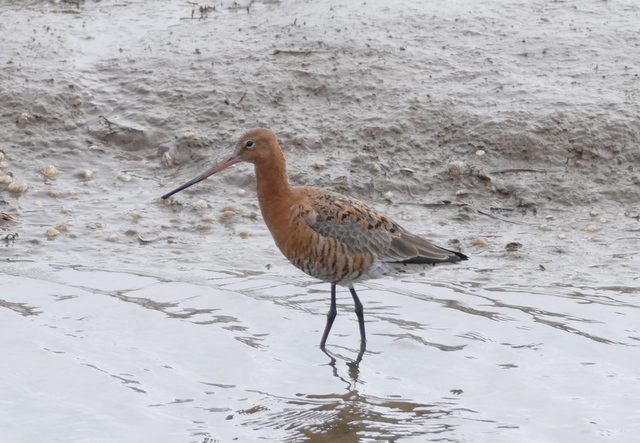 Black-tailed Godwit – some are now getting very orange
Black-tailed Godwit – some are now getting very orange
There were other waders to see as well. A couple of Turnstone were skulking on the islands and two Grey Plover were asleep nearby. A pair of Oystercatcher had taken occupation of a loose pile of old bricks on one of the islands and a Snipe attempting to hide next to them was not very well camouflaged! A couple of Ruff and a much smaller Reeve were working their way round the edges – one of the males was much more advanced in moult, with lots of rufous tiger-striped feathers in its upperparts. A close group of about twenty Redshank was bathing off one of the spits and a couple of Greenshank suddenly dropped in with them. They joined in the bathing for a while, before flying off calling noisily.
The number of ducks seems to have dropped a bit, like the water levels. There were still quite a few Teal, Gadwall and Shoveler, but fewer than in recent weeks. Large flocks of Brent Geese were still out in Thornham Harbour and over towards Brancaster, and some of them dropped into the reserve. However, the surprise was finding a couple of Pink-footed Geese on the top of the bank around the freshmarsh – most of them left in February!
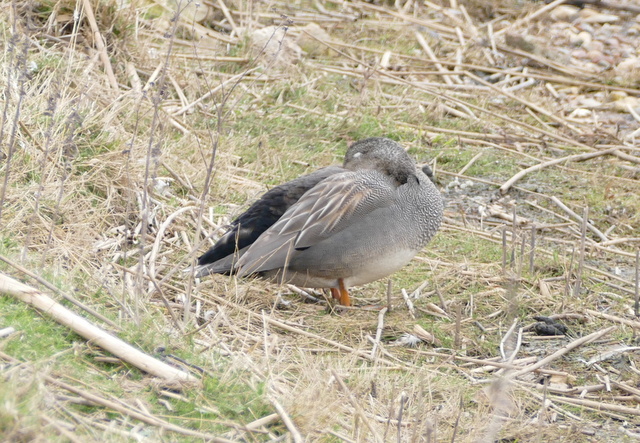 Gadwall – mostly sleeping today
Gadwall – mostly sleeping today
The Volunteer Marsh was rather quiet today. On the tidal pools, we stopped to admire a pair of Pintail, though they were a little more distant today. A pair of Avocet were feeding by the path. Out on the beach, the tide was on its way out. There were several Ringed Plover out on the sand towards Brancaster. The Sanderling were all miles off in that direction at first as well, but a couple of them flew round with some Oystercatcher and Grey Plover and landed on the shoreline in front of us. A tight flock of Dunlin flew west just offshore. The sea was flat calm, but mostly empty apart from three distant Common Scoter and a brief Harbour Porpoise which was even further out.
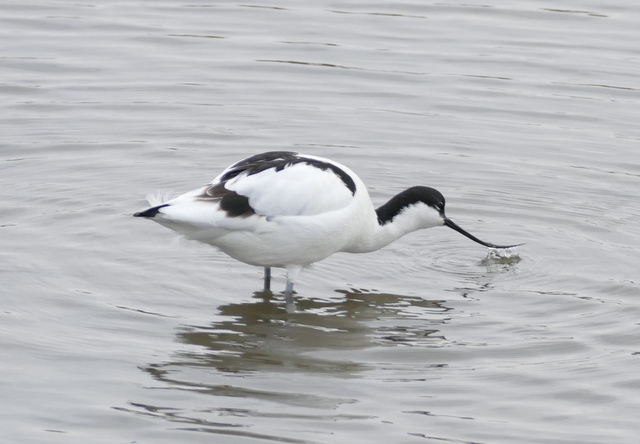 Avocet – no write-up is complete without an Avocet photo!
Avocet – no write-up is complete without an Avocet photo!
We walked back via the Meadow Trail and a quick detour via Patsy’s Reedbed. There was nothing new out there – another three Red-crested Pochards. But while we were standing there, a Swallow appeared over the water. It didn’t linger, and flew quickly west over the Fen Hide. One Swallow…
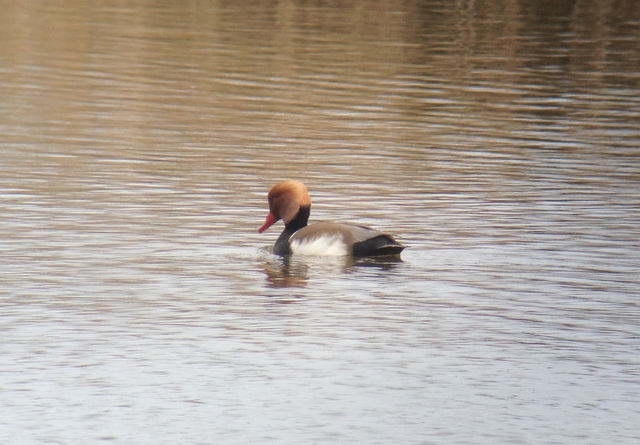 Red-crested Pochard – lots on the reserve at the moment
Red-crested Pochard – lots on the reserve at the moment
When we got back to the car park, it was full – lots of cars and lots of people. We decided to head somewhere quieter for lunch, so drove up to Choseley. The area around the drying barns was quiet, apart from a couple of Yellowhammers, but at least the sun came out as we had lunch. We had a drive round the area, but we couldn’t find any Corn Buntings – they seem to be very thin on the ground this year. There were lots of Brown Hares – at least 30 in one field. And we almost ran over a pair of Grey Partridge which ran across the road.
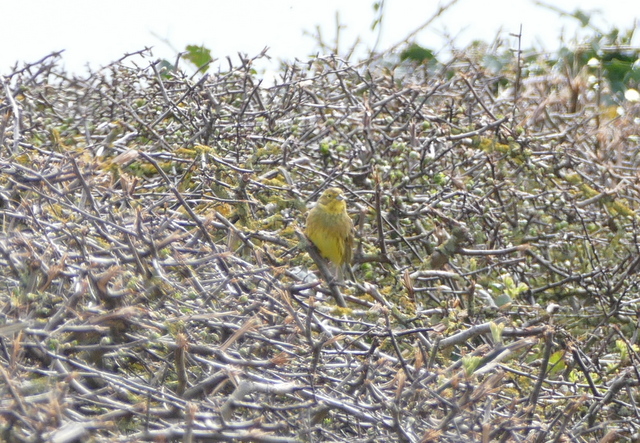 Yellowhammer – a couple flew round the hedges as we ate lunch
Yellowhammer – a couple flew round the hedges as we ate lunch
After lunch, we headed over to Holkham. Lady Anne’s Drive was full almost to bursting, but we still managed to find a space down near the end, as some people had obviously moved on after a morning on the beach. It was quieter walking west inland of the pines, especially once we got beyond Washington Hide. There were more Chiffchaffs singing from the trees, several Goldcrests feeding in the Holm Oaks with a variety of tits and Treecreepers calling. A small group of Siskin were feeding high in the pines by Meals House, presumably waiting for an opportunity to head off back north.
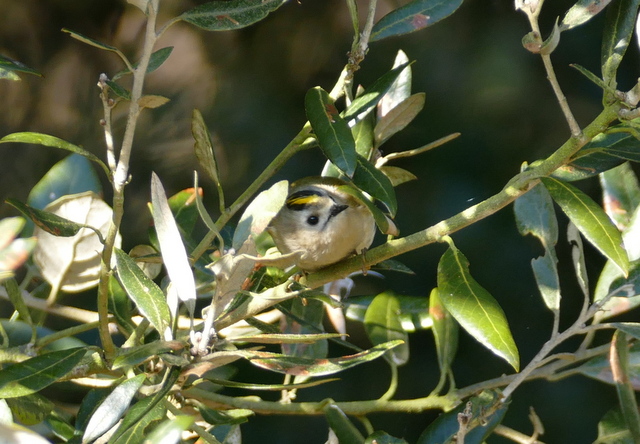 Goldcrest – feeding in the Holm Oaks by the path
Goldcrest – feeding in the Holm Oaks by the path
We headed up to Joe Jordan Hide and as soon as we sat down we picked out a single Spoonbill on the front of the pool. We could see it collecting nest material and once it had a bill-full, it flew up into the trees. There didn’t seem to be much more activity – perhaps nest building has already proceeded apace. However, there were other things to look at from the hide.
Lots of Marsh Harriers were circling over the grazing marsh. Scanning though the Greylags and Egyptian Geese, we picked up a few lingering Pink-footed Geese. Two of them clearly were injured, with obviously drooping wings, but the other three showed no signs of injury. Four Jays were probing around on the bank of a ditch – presumably having forgotten where they buried the acorns last autumn! A Stoat was sniffing around amongst the molehills.
We decided to move on to look for migrants in the dunes. A little further on, looking from the track, it was suddenly clear why the Spoonbills were not making themselves visible – we could see two sleeping in the trees.
From up in the edge of the dunes, we scanned the grazing marshes. Far off in the distance, over the Burnham Overy seawall, we could see a raptor circling. Even though we were looking into the sun, it could only be one thing. We could just see its white tail catch the light. There has not been any report of the wintering Rough-legged Buzzard for several days, but it was still present after all. Then it turned towards us and sailed down to one of its favourite fenceposts. Business as usual. Despite the heat haze, we could clearly make out the pale head and blackish belly patch. Surely it can’t be long now before it leaves?
 Rough-legged Buzzard – still present after all
Rough-legged Buzzard – still present after all
We walked on west through the dunes. We had been told about a Wheatear along the fence line, but we couldn’t find it. There were lots of Meadow Pipits and Linnets feeding in the short grass. We got almost to the end of the boardwalk on the seawall, before we ran out of time and had to turn back. As we did, there was the Wheatear, back where it had been before we had looked for it. It was a very smart male. We watched it for some time, running back and forth, before it suddenly disappeared again.
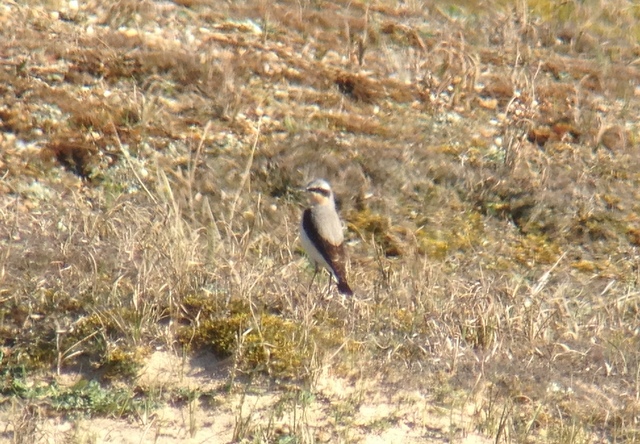 Wheatear – a cracking male in the dunes
Wheatear – a cracking male in the dunes
While we were looking for the Wheatear, we picked up another Swallow heading west along the top of the dunes. Our second of the day – does that mean it is summer? It certainly felt like spring now, with the sun shining. We were desperately shedding layers, as it started to warm up, in stark contrast to the cold morning.
The walk back was fairly uneventful – the Spoonbills still sleeping in the trees and the tits and Goldcrests still in the pines and Holm Oaks – at least until we got to Lady Anne’s Drive. It had been a surprise not to see a Barn Owl out over the grazing marshes from the dunes, but one was perched on a fence post as we got back. We walked over to look at it and then a second one flew in and landed right next to it – two Barn Owls together. They sat there for some time, giving us great views through the scope, before one flew off along the bank behind. As we watched it fly off, we realised yet another Barn Owl was flying in along the bank from the other direction, with a fourth Barn Owl just behind it. Wow! We stood transfixed as we watched them all hunting in the afternoon sun. A stunning way to end the day.

















